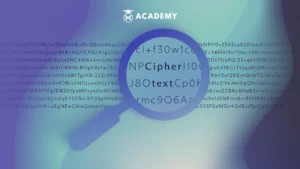In cryptography, one important term related to encrypted text is ciphertext.
Ciphertext itself is important to maintain the security and confidentiality of information.
In addition, as is commonly understood, cryptography is a system and method for storing and sending data in a form that can only be understood by the parties involved in this process.
So, what is ciphertext, and what does it do? To find out more about ciphertext, see the following review.
Get to know the term ciphertext

The ciphertext is the encrypted text changed from plaintext using an encryption algorithm to maintain user data security.
The ciphertext cannot be read before it is changed again to plaintext through an encryption process with a key called a “cipher.”
Did you know that cryptography is very important in maintaining information system security? Because it can maintain data confidentiality, integrity, authentication, and public trust.
The reason is, as discussed earlier, with cryptographic methods, data can be stored and sent in a form that can only be understood by the parties involved.
Definition of Ciphertext
Ciphertext is the result of encryption on plaintext using an algorithm called a “cipher.”
The use of ciphertext has at least been carried out since the time of Julius Caesar for military operations.
Meanwhile, the ciphertext is generally used for messages sent via the internet for security purposes.
As for the encryption process in cryptography, the plaintext will be changed to be unreadable by any person/device that does not have the decryption key to convert it back into the original plaintext form.
Please note, in this case, the algorithm is the cipher used to create the ciphertext.
Therefore, the ciphertext is arguably the result of applying the encryption algorithm.
Meanwhile, the message will be encrypted using a cipher key to send messages using ciphertext.
Later, when the message arrives at the address it was sent to, the message must be parsed/decrypted to get the intent of the plaintext so that, in this case, a passkey is needed.
Ciphertext Function
Ciphertext plays an important role in maintaining information security.
The reason is, until now, the developers are still paying great attention to security issues.
This important issue is, of course, closely related to client data and privacy. Well, ciphertext itself is here to solve this problem.
Ciphertext can ensure the confidentiality of the message with the encryption key on the message sent.
In this case, two keys are needed for encryption and decryption, namely the private and public keys, for correspondence that utilizes public key cryptography.
Here, the sender will use the public key to encrypt the plaintext, while the recipient does not know the private key.
On the other hand, the recipient has a public key to decrypt the ciphertext and access the message.
Regarding how to read ciphertext, only with the decryption key can this encrypted data be converted back to plaintext.
As mentioned above, there are two types of keys in public key encryption: public and private keys.
Examples of Using Ciphertext
Examples of using ciphertext in cryptographic applications can be found in email, chat, and computer data.
As is known, in cryptography, ciphertext aims to protect confidential data and information so that it cannot be read by hackers/parties with malicious intent.
In chat applications, for example, encrypted data will be found that cannot be accessed by other people, especially hackers.
Meanwhile, examples of implementing cryptography in software and hardware can be seen in using Caesar Cipher to Vigenere Cipher types of ciphers and transactions at ATMs and using credit cards.
The difference between Ciphertext and Cipher
There are differences between the terms ciphertext and cipher, but they are often considered the same.
The ciphertext is the result (output) of an encryption process. At the same time, the cipher is a key cryptography algorithm applied to certain plaintext/information that will be converted into ciphertext.
The cipher itself is needed to convert the ciphertext into plaintext that can be read and understood by parties related to the data/information.
If there is no cipher, the ciphertext will not be understood by the recipient of the data/information.
Therefore, the cipher is more closely related to the encryption method and process.
Meanwhile, the types of ciphers are as follows:
1. Caesar Cipher
Caesar cipher is the simplest type of cipher with the concept of substitution.
The way to do this is to shift the alphabet, numbers, or numbers in the plaintext three positions down.
For example, the letter A is substituted/replaced by the letter D and so on.
2. Monoalphabetic Cipher
Monoalphabetic cipher is a type of advanced cipher. Caesar’s cipher was considered weak and vulnerable to penetration.
This cipher type will replace each alphabet in plain text with any other alphabet except the original one.
For example, the letter A can be replaced by another alphabet, starting from the letter B to Z and so on.
3. Homophonic substitution ciphers
The homophonic substitution cipher is a type of cipher that has an application concept almost the same as the monoalphabetic type above.
However, the difference is that if a monoalphabetic replaces one alphabet with another, then in homophonic, one alphabet can be substituted using a fixed alphabet/a set of alphabets.
For example, the letter A, which is substituted, is replaced by the letter X; thus, the letter A will still be replaced by the letter X.
4. Polygram substitution cipher
The polygram substitution cipher is a type of cipher that differs from the previous ciphers.
The reason is in this type of cipher, and substitution is made of one alphabetic block with another alphabetic block.
The system is considered more efficient than replacing one character/alphabet one by one.
An example can be seen in the change in the EDUCBA block to XYQLAB so that when the EDUCBA block appears, it will automatically be changed to XYQLAB.
However, if this block is cut, for example, only the EDU block is left, the replacement may be another block; alias XYQ is uncertain.
5. Polyalphabetic substitution cipher
Polyalphabetic substitution cipher or Vigenere cipher is a type of cipher that utilizes an alphabetic text encryption method using several substitution letters.
Introduced by the cryptographer born in 1406, Leon Battista Alberti, this type of cipher can be done using the Vigenere table (Vigenere square).
This table contains 26 letters written in different rows. In this table, cyclically, each alphabet will be shifted to the left, referring to the previous alphabet.
For example, in writing EDUCBA with the keyword Apple. The letter E encryption process will be paired with the letter A, which is the first letter of the key.
It would help to use row E and column A from the Vigenere table, namely the letter E.
Furthermore, the rest of the original text from the EDUCBA writing will be encrypted to become ESJNFA.
Risks and Threats to Ciphertext
Several security risks can threaten ciphertext that is important to pay attention to, including:
1. Encryption strength
The first risk to watch out for from ciphertext is the strength of the existing encryption.
The ciphertext can be very vulnerable to attack if the encryption can be compromised, i.e., when the decryption key is detected as weak/easily guessed.
2. Compromise decryption key
The second risk is a compromise of the decryption key. If there is a compromise/theft of the decryption key used to open the ciphertext, the data/information can be read by parties who do not have authority over it.
3. Threat of cyber attack
Next, the threat of cyber attacks is also a ciphertext risk that needs attention.
For example, the type of brute force attack is when the attacker tries to test various decryption key combinations to open the ciphertext.
4. The strength of the encryption algorithm
In addition, the strength of the encryption algorithm can also be a risk.
The reason is that an encryption algorithm may need to be stronger than ciphertext protection from attacks.
Therefore, the ciphertext can also be threatened if the encryption algorithm used is considered weak or outdated.
5. Human error
The human error factor can also be a risk that threatens ciphertext.
For example, in the form of negligence/carelessness when managing decryption keys or when maintaining ciphertext security.
This is likely to result in data leakage, even a security compromise, which is very dangerous to the owner/recipient of the data.
6. Dependence on technology
Finally, the risk that must be faced is dependence on technology.
This can also pose a security risk in the sense that when a certain encryption technology is deemed obsolete/assessed as insecure, there will be a threat to the ciphertext generated by utilizing that technology.
How to Protect Ciphertext

Here are some ways to protect ciphertext so that unauthorized parties, namely cannot access it:
1. Using strong encryption
First of all, you must use strong encryption and ensure that attackers will find it difficult to read the existing ciphertext.
In this case, a strong encryption algorithm and a sufficiently long key are indicators of strong encryption.
2. Protect the decryption key
Second, you must protect the decryption key by not giving it to anyone with the authority to open it.
To protect the decryption key, you can store it in a physical security system that is guaranteed to be safe, for example, in a locked vault or safe.
3. Using proper security protocols
Next, you can use the proper security protocols. This is related to efforts to store (transmit) ciphertext.
You can use Secure Sockets Layer (SSL) or Transport Layer Security (TLS) when transmitting data over a network.
Besides that, you can also use the same security protocol while storing data on the server/on the local storage device.
4. Using modern encryption technology
The next way is to use modern encryption technology.
Here, you can use quantum encryption and other safer encryption technologies.
5. Using additional security technology
Finally, you can use additional security technologies such as antivirus, firewall, and other security programs.
The goal, of course, is to protect your data from threats that might occur.
Conclusion
In conclusion, the ciphertext is encrypted text or encrypted text that is changed from plaintext by using an encryption algorithm to maintain the security of user data.
It is important to understand ciphertext and cryptography because cryptography plays an important role in maintaining the security of information systems.
This is because cryptography can maintain data confidentiality, data integrity, authentication, and public trust.
In addition, it is also very important to maintain information security by using ciphertext.
This is because the confidentiality of data and information will be better maintained using this method.
Meanwhile, how to protect ciphertext from security threats is as follows:
- Uses strong encryption
- Protects the decryption key
- Use proper security protocols
- Using modern encryption technology
- Using additional security technology
Do you understand what ciphertext is and its important role in life?
So, apart from the importance of ciphertext in maintaining information systems, you can also read other interesting articles, such as keyloggers and security threats to crypto assets, only at INDODAX Academy.








